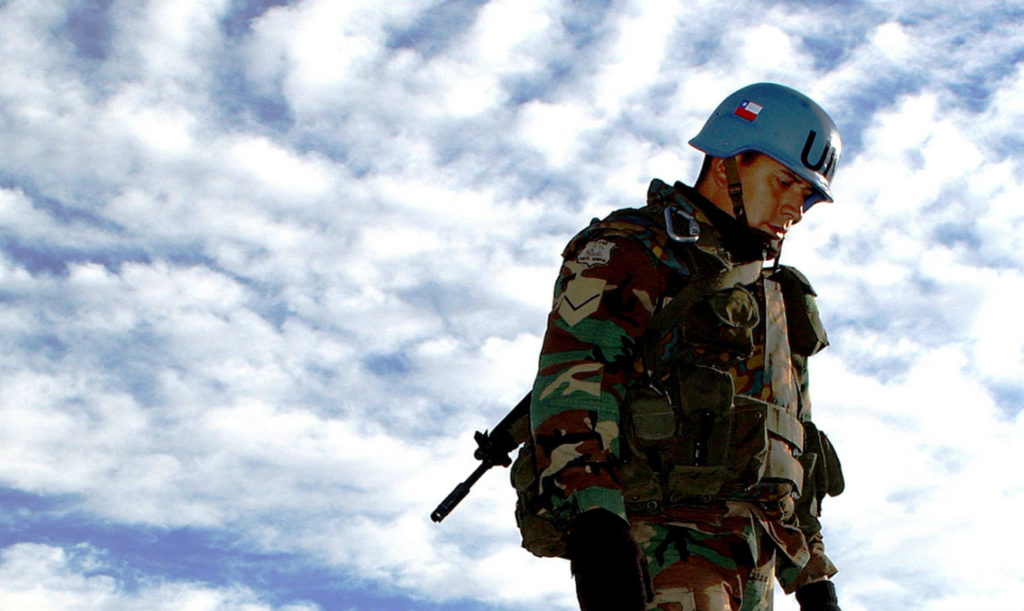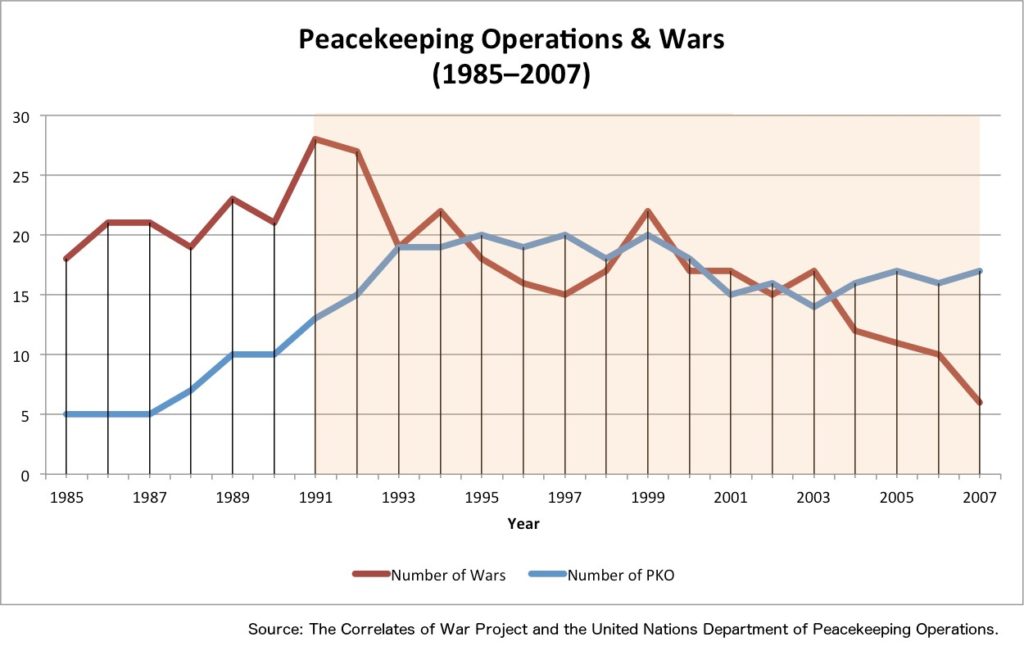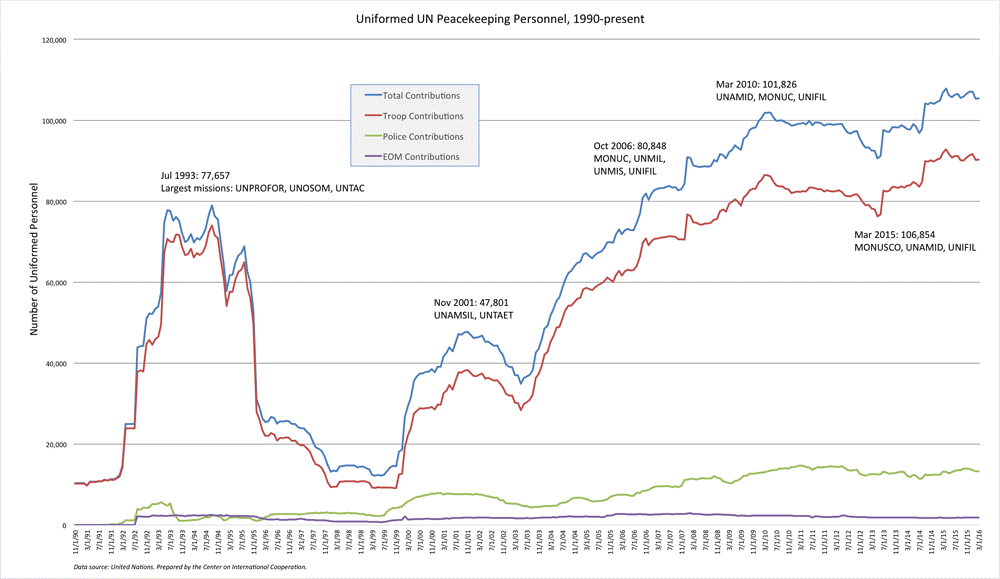Playing the Blues: A Professional Peacekeeping Force for an Age of Violent Extremism

While most of the world enjoys the benefits of peace and growing prosperity, Juba, the capital of South Sudan, is awash in violence. This new country won its independence from Sudan just five years ago and has seen little peace since. With an estimated 50,000 dead since 2013, massacres of civilians, rapes of young girls, destruction of relief supplies, and forced child soldiers have become part of South Sudan’s bleak existence. In 2014, the U.N. Security Council dispatched a supplemental U.N. peacekeeping force to reinforce existing U.N. personnel, protect civilians, monitor human rights, facilitate humanitarian aid deliveries, and support the faltering ceasefire agreement. But the current 13,000-person force has been hard pressed. It stands accused of hiding in its camps and refusing to prevent ethnic violence and rapes within sight of its base in Malakal. Additional forces have been ordered in, but U.N. peacekeepers’ checkered record in Africa, replete with rape and sexual predation, does not offer any confidence in the force’s capacity to create rapid change in South Sudan’s virulent conflict.
U.N. peacekeeping operations were once well-recognized as an effective tool for mitigating and managing violent conflict. As shown in Figure 1, an increase in the 1990s in the number and scale of U.N. peacekeeping operations helped produce a substantial decline in the number of active conflicts. But much has changed. Today, there are major questions about the quality of forces for long missions and reasons to believe that future peacekeeping missions will continue to face challenges similar to those experienced in South Sudan.

Over its existence, the U.N. has approved a total of 69 peacekeeping operations, in which more than 3,000 peacekeepers have died. Today, there are more than 100,000 U.N. peacekeepers deployed to 16 missions around the world. The upward historical trend for uniformed peacekeeping troops since 1990 is shown in Figure 2, reflecting continuously increasing demand over time. The U.N. peacekeeping budget is now almost $8 billion per year. The United States contributes 28 percent of these funds, as the largest financial contributor. Collectively, the major European powers contribute a similar amount. However, money alone does not guarantee high performance.
The continued success of U.N. and regional peacekeeping operations remains predicated upon a number of factors: international support and U.N. Security Council concurrence, troop contributions from member states, and resource contributions. The environment for these factors does not look good in the future, which puts the efficacy of these valuable contributors to peace at risk. We could soon be singing the blues for the blue helmets.

The complexity of peacekeeping operations has evolved and increased substantially in the last few decades. The number of major civil wars to which U.N. troops were deployed jumped from four in 2007 to 11 in 2014. These conflicts are more intractable, violent, and influenced by organized crime than ever before. Foreign fighter flows from outside of major conflicts extend the length and heighten the violence of many contingencies, such as Syria. Nearly two-thirds of U.N. military peacekeepers and 90 percent of total U.N. personnel deployed today operate in countries experiencing sustained violent conflict rather than a negotiated truce. In other words, as noted recently at War on the Rocks by David Ucko in the context of South Sudan, there is no peace to keep in many of these conflicts.
Despite U.N. headquarters pulling them away from some missions when violence flared up, fatalities among U.N. peacekeepers have increased in the aggregate. Contingencies for peacekeeping operations are increasingly complex and call for robust capabilities to impose security instead of relying on the permission of opposing parties. Robust peacekeeping operations face severe challenges and require highly trained personnel, effective offensive combat equipment, coherent command and control, and strong leadership in ambiguous environments. The need to enhance peacekeeping forces for such operations has been recognized by a high-level U.N. assessment.
Still, prospects for successful U.N. operations are challenged given the evolving security environment. First, international support requires a consensus of major players on the U.N. Security Council, which may evaporate given increased tensions between the West and China or Russia. In the last decade, the number of Security Council vetoes doubled. Second, the availability of troops is liable to decline if major states face higher security dilemmas at home and cannot financially sustain these operations. Not surprisingly, given domestic security challenges and tighter economic conditions in Europe, U.N. peacekeeping contributions from the EU are in arrears. Magnus Nordenman puts it well:
A newly assertive Russia and a crumbling Middle East has European decision makers worried that their militaries (exhausted by Afghanistan and shrinking due to budget cuts) may be needed closer to home.
Finally, resources and commitments are already sliding. The U.N. Secretary General has called for increased support for peacekeeping while warning of harder mandates and higher costs. The U.S. ambassador to the United Nations felt it necessary to call for increased assistance levels from Europe, and President Obama has called attention to the importance of these missions. There have even been calls for increased U.S. military force participation to bolster lagging capacity.
There are a few positive signs. China’s increased willingness to participate in peacekeeping operations is one such sign. This reflects a major change in Beijing’s position on international conflict mitigation, and the shift has not been without costs to China. Chinese peacekeepers suffered casualties in Mali and South Sudan. Hopefully China will continue increasing their support despite these setbacks, because other nations are facing fierce resistance when attempting to boost their contributions. For example, in August, the Canadian government pledged to reinvigorate its contribution to peacekeeping tasks, but the opposition party immediately questioned the wisdom of that initiative. The gap between the supply of suitable forces and rising demands for deployments to increasingly difficult conflicts will continue.
What is the solution? It is time for the United States to push for the creation of a standing U.N. Peacekeeping Force. This proposal offers three major advantages. First, it would reduce the need for national contingents from willing nations in high risk scenarios. Second, it would facilitate the professionalization of a force that specializes in complex contingencies and is trained, organized, and equipped for sustained peacekeeping missions. Reliance upon volunteers who are committed to the mission, prepared to comply with international law, and are dedicated to the expectation for protecting civilians and enforcing U.N. mandates would be a clear improvement. Third, the deployment of a dedicated force of professionals would eliminate the political repercussions now faced by national leaders when their units are attacked and sustain fatalities. Multinational units comprised of highly trained volunteers would minimize the risks faced by political leaders who would not be held accountable at the ballot box for casualties. These three benefits negate the costly downsides of 21st-century peacekeeping missions. Most importantly, the establishment of a standing force of blue helmets will ensure that the U.N. Security Council’s mandates are executed as intended.
National contingents could still be employed for providing more advanced combat capabilities, such as artillery or strike aircraft. Additionally, national forces could still be employed where cohesive combat teams were needed or for traditional peacekeeping missions in which neutrality is observed. The robust U.N. Peacekeeping Force of 25,000 to 40,000 uniformed personnel would be reserved for deployment to dangerous missions and employment in dampening crises.
Admittedly, this is not an original idea. And just as people have called for such forces before, there is no shortage of naysayers insisting this cannot work. The critics, however, have not been able to show how the current system — with its lengthy deployment times, qualitatively limited troops, and endemic human suffering — is the right system. Such an argument would be difficult to make. Nor has anyone dealt with the political realities and the rising impact of terrorism that has resulted in shortfalls in pledged units. This updated proposal is a significant step toward an effective response. It is not a panacea, but credible, bespoke units prepared for this mission are better than ill-disciplined and ad hoc forces drawn from the developing world.
Overall, the demand for U.N. mandated operations is running up against the complexities of the changing security environment, including increased threats to civilians from foreign fighters and violent extremists. Based upon current pressures and the increased political and personnel costs of peacekeeping operations, such operations are likely to be fewer and increasingly hard-pressed to preserve the peace. While these are valuable conflict mitigation efforts, the rise in conflict is likely to increase the costs of such missions while diminishing their effectiveness. A dedicated international force responsive to the U.N. Security Council increases the chances of meeting challenges in the age of violent extremism.
Frank Hoffman is a Contributing Editor at War on the Rocks, and a Distinguished Research Fellow at NDU’s Institute for National Strategic Studies. Ryan Neuhard is a 2016 graduate of William and Mary and is currently a research associate. These are their own views, which do not reflect the policy or position of the U.S. government.

